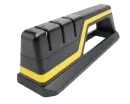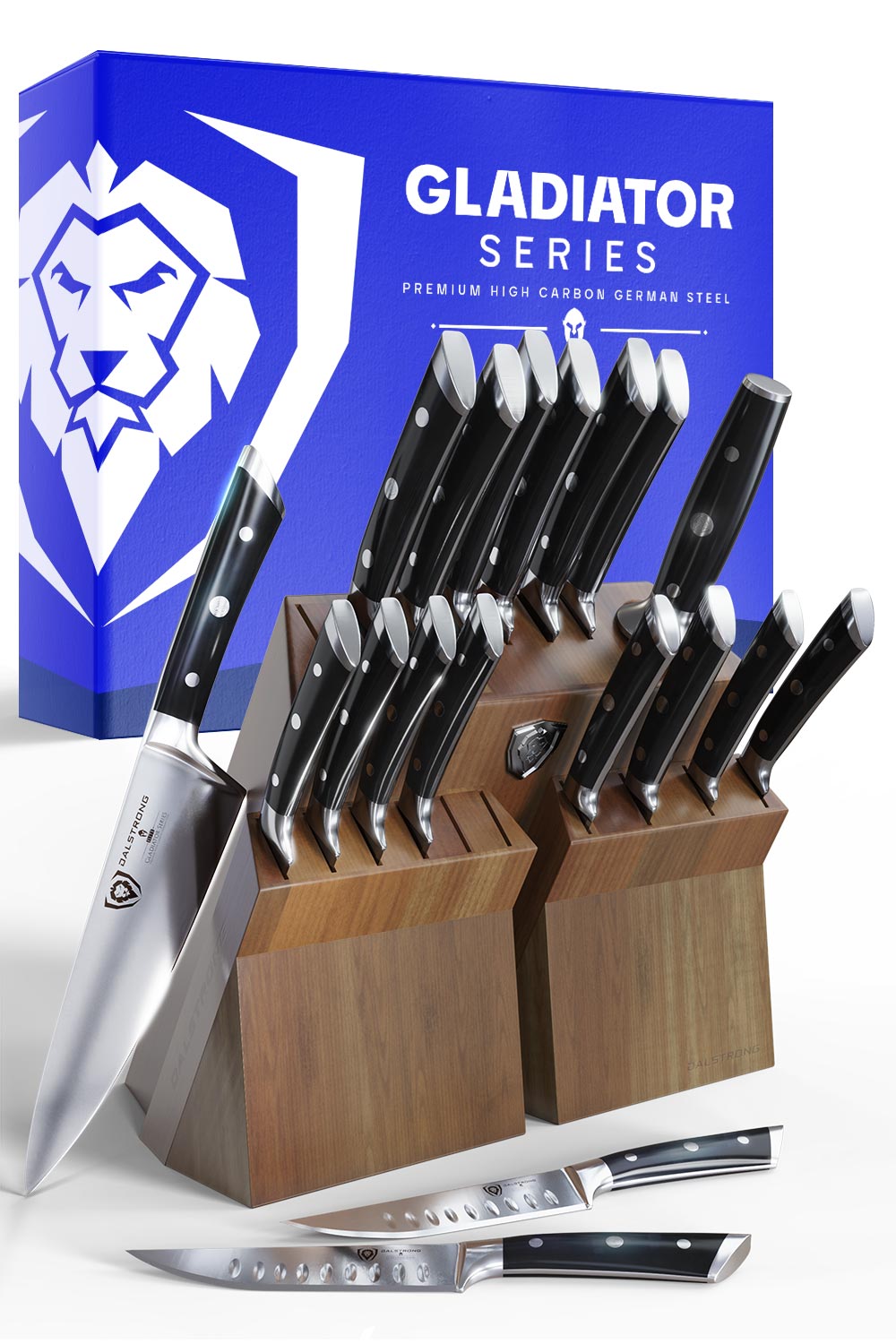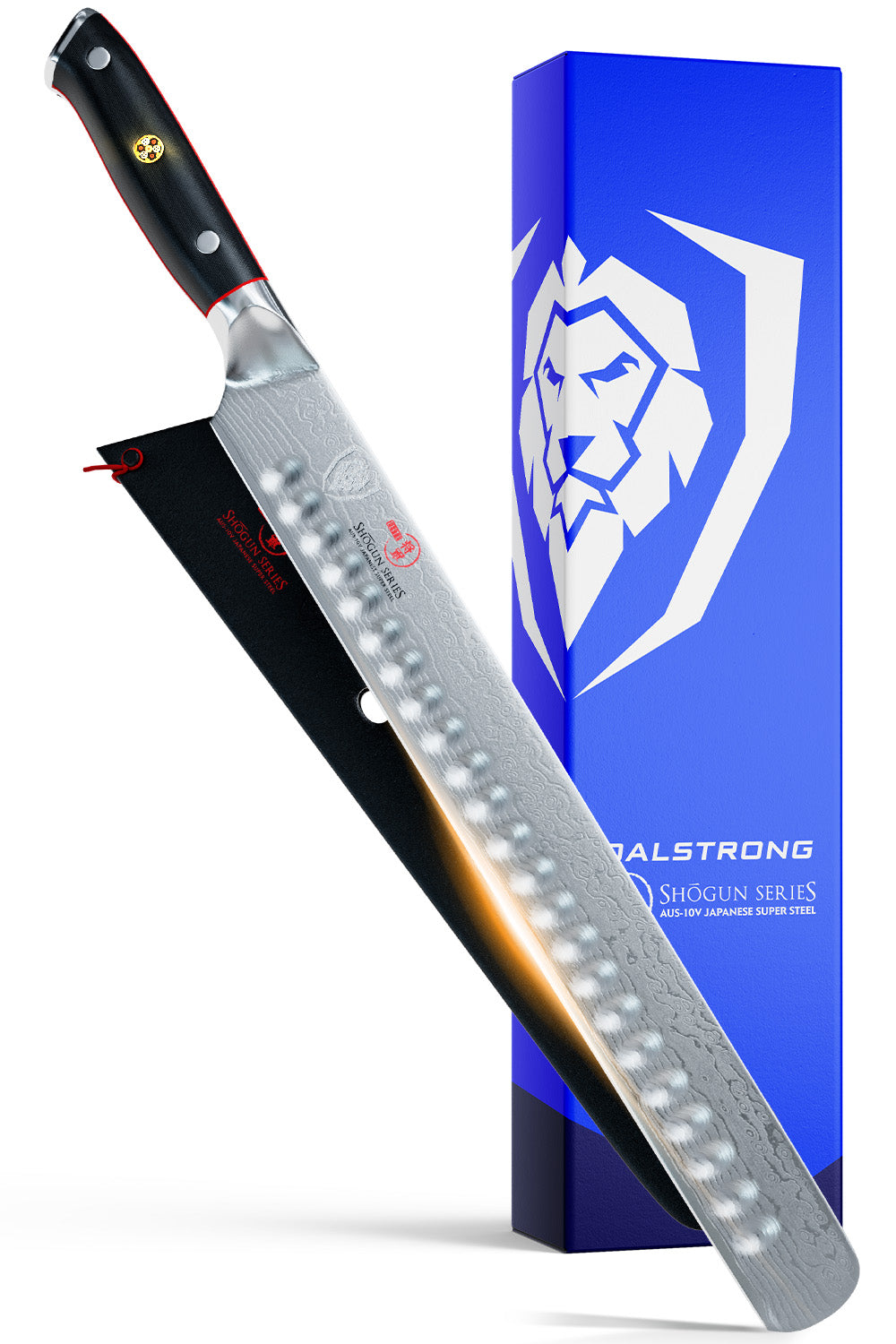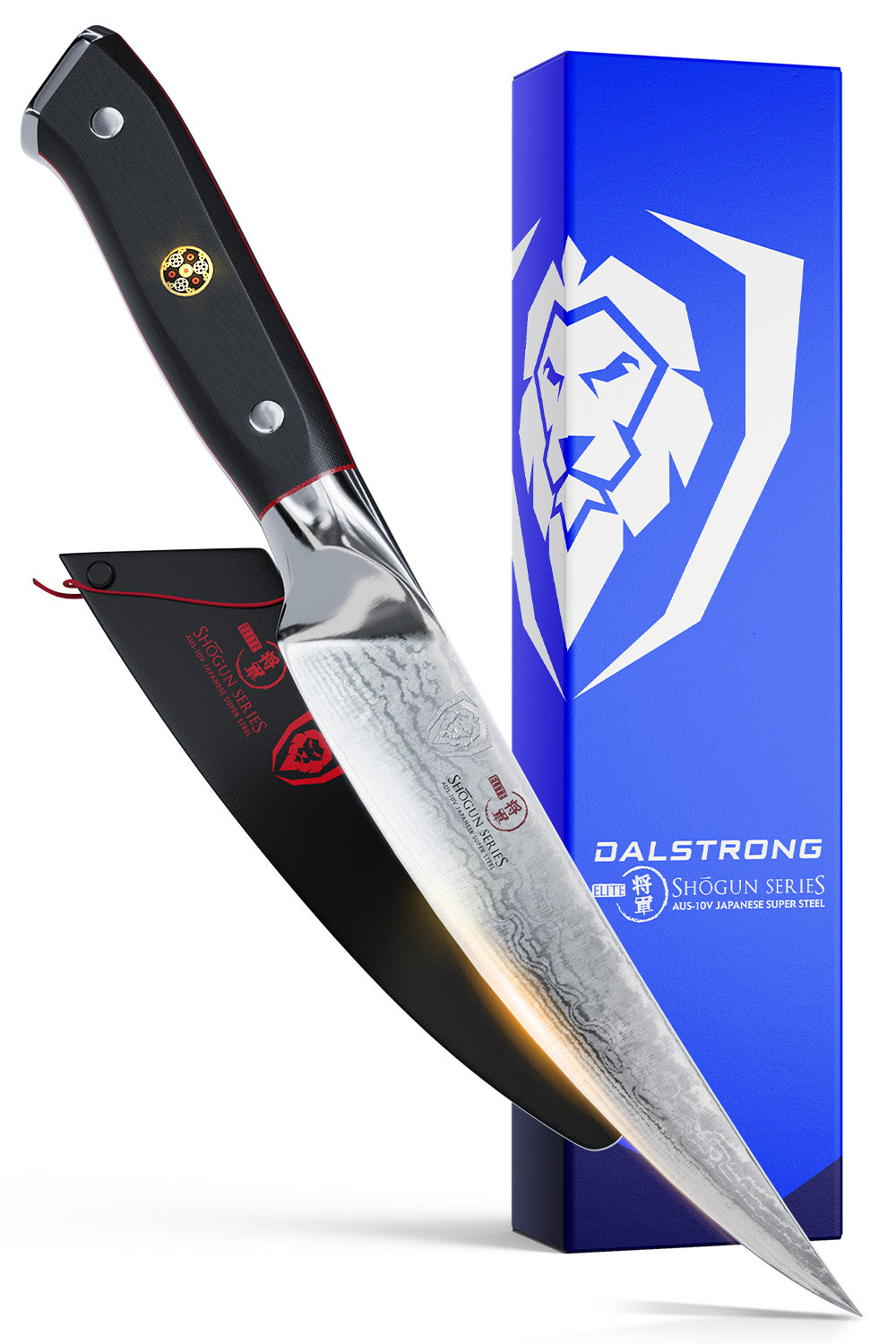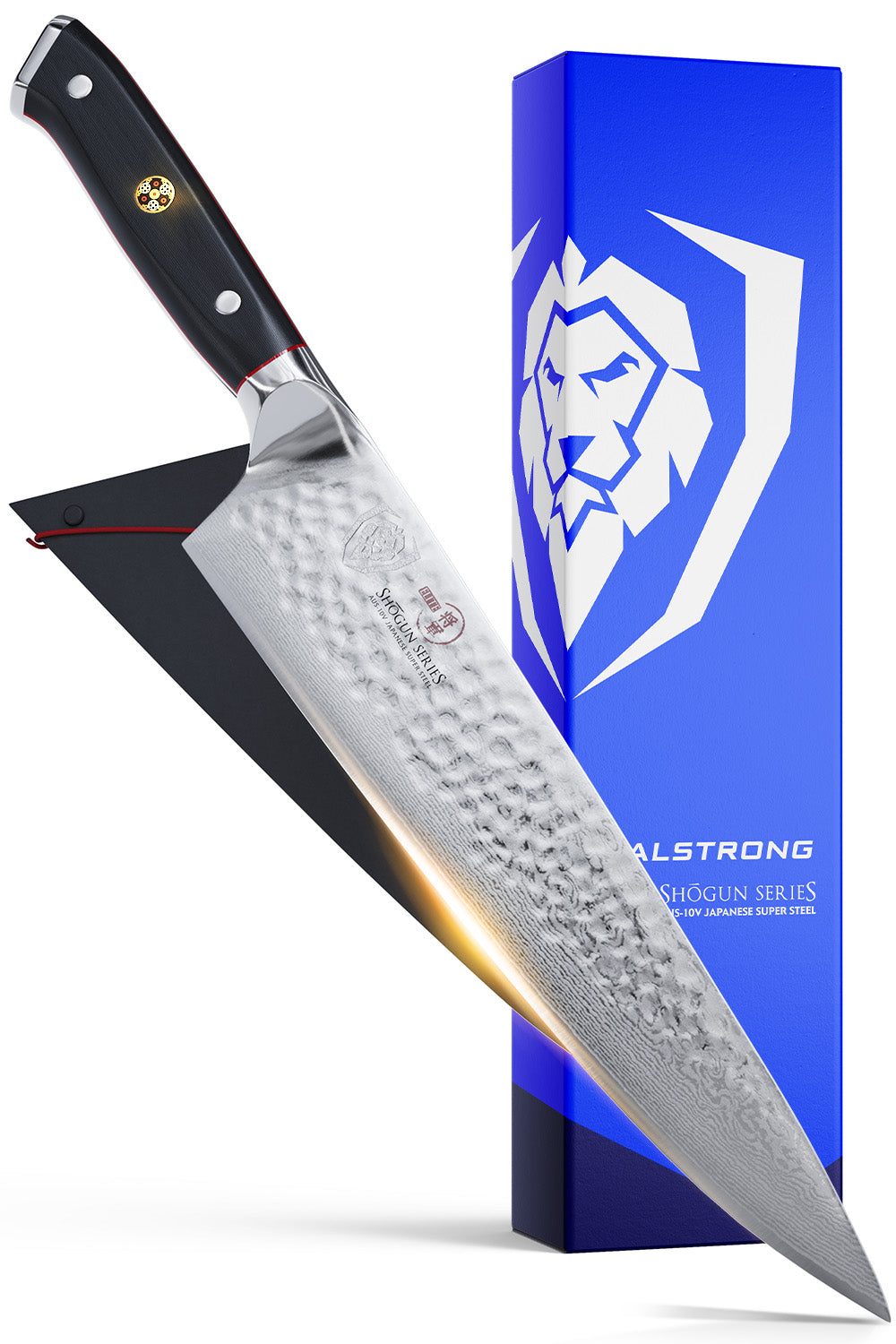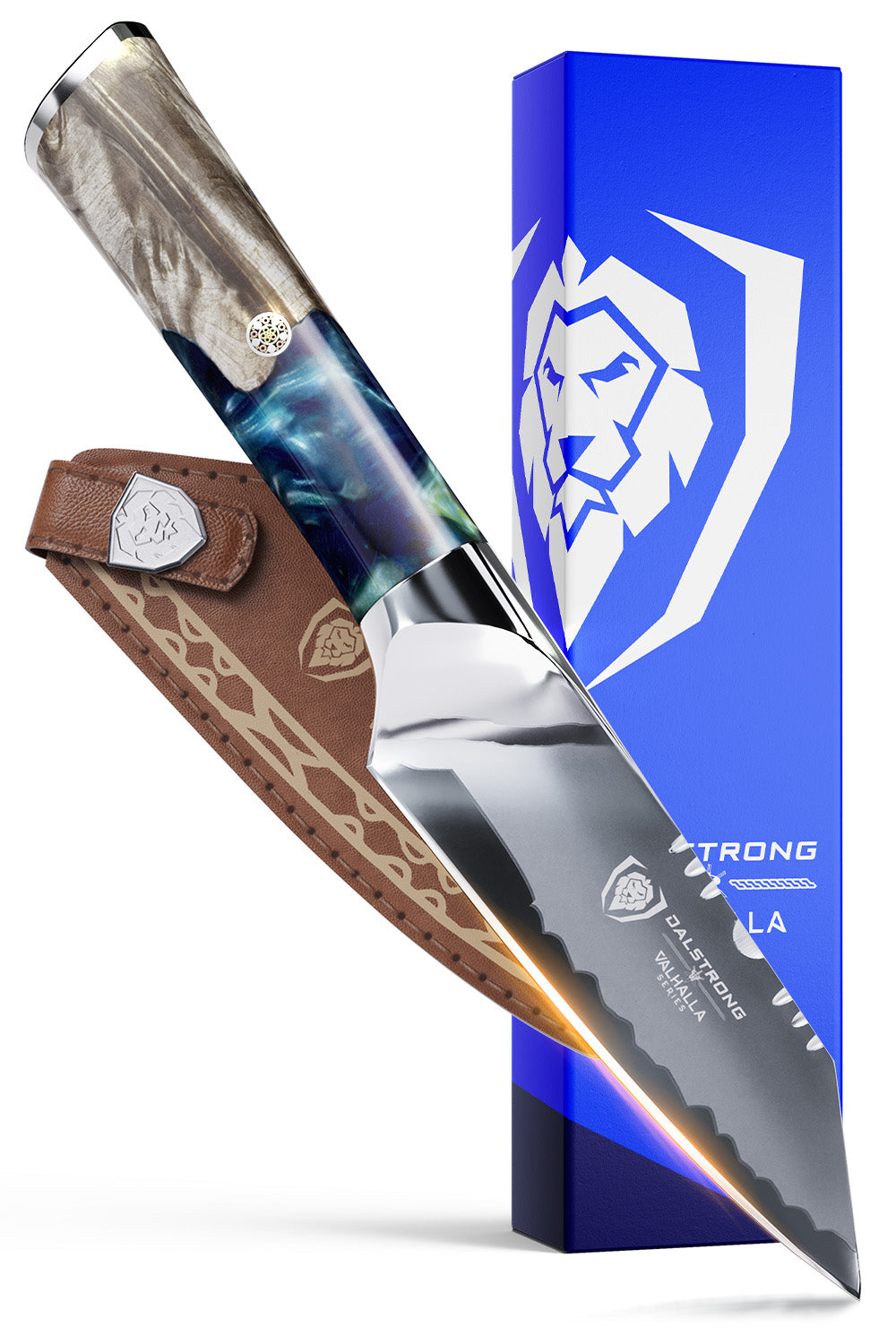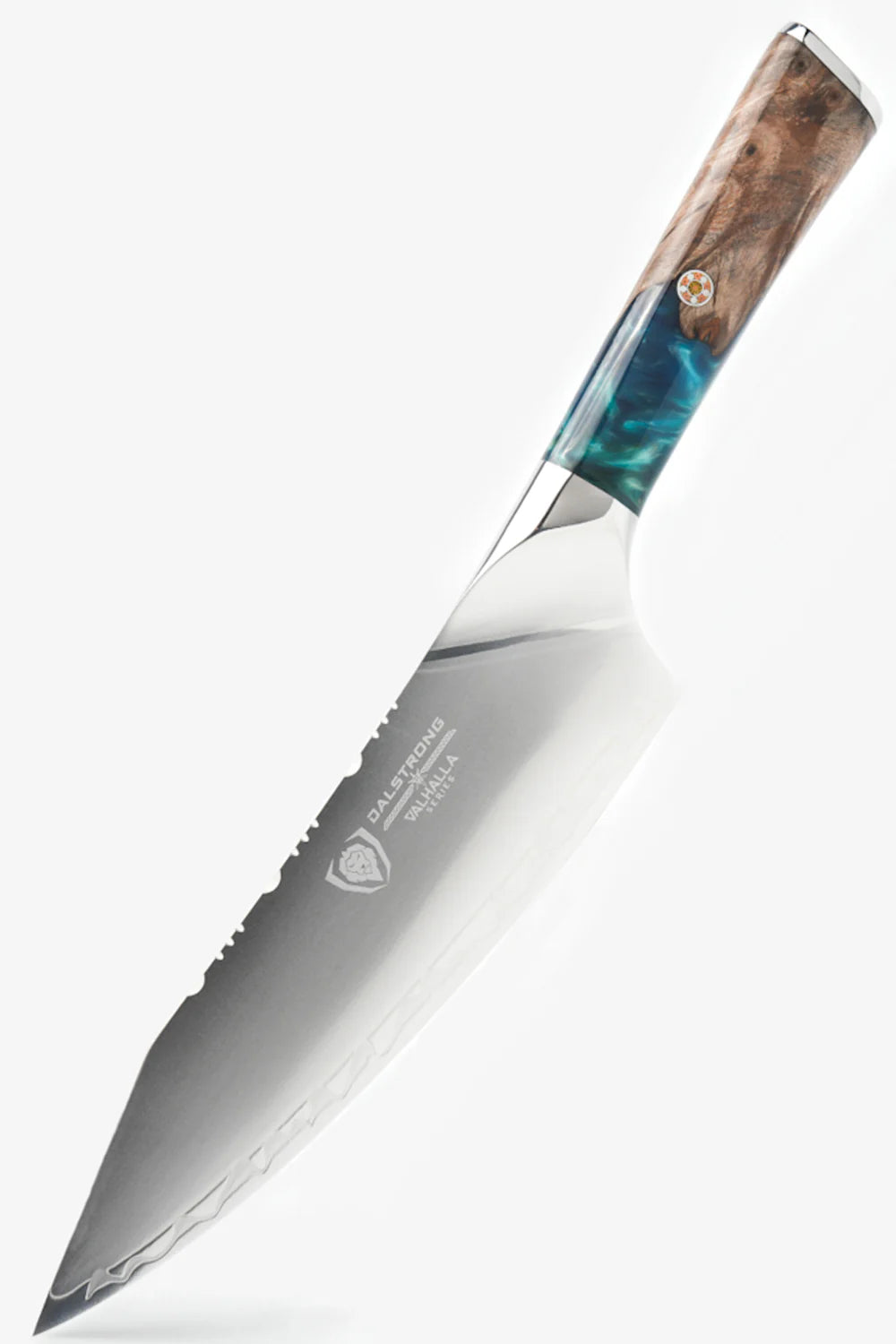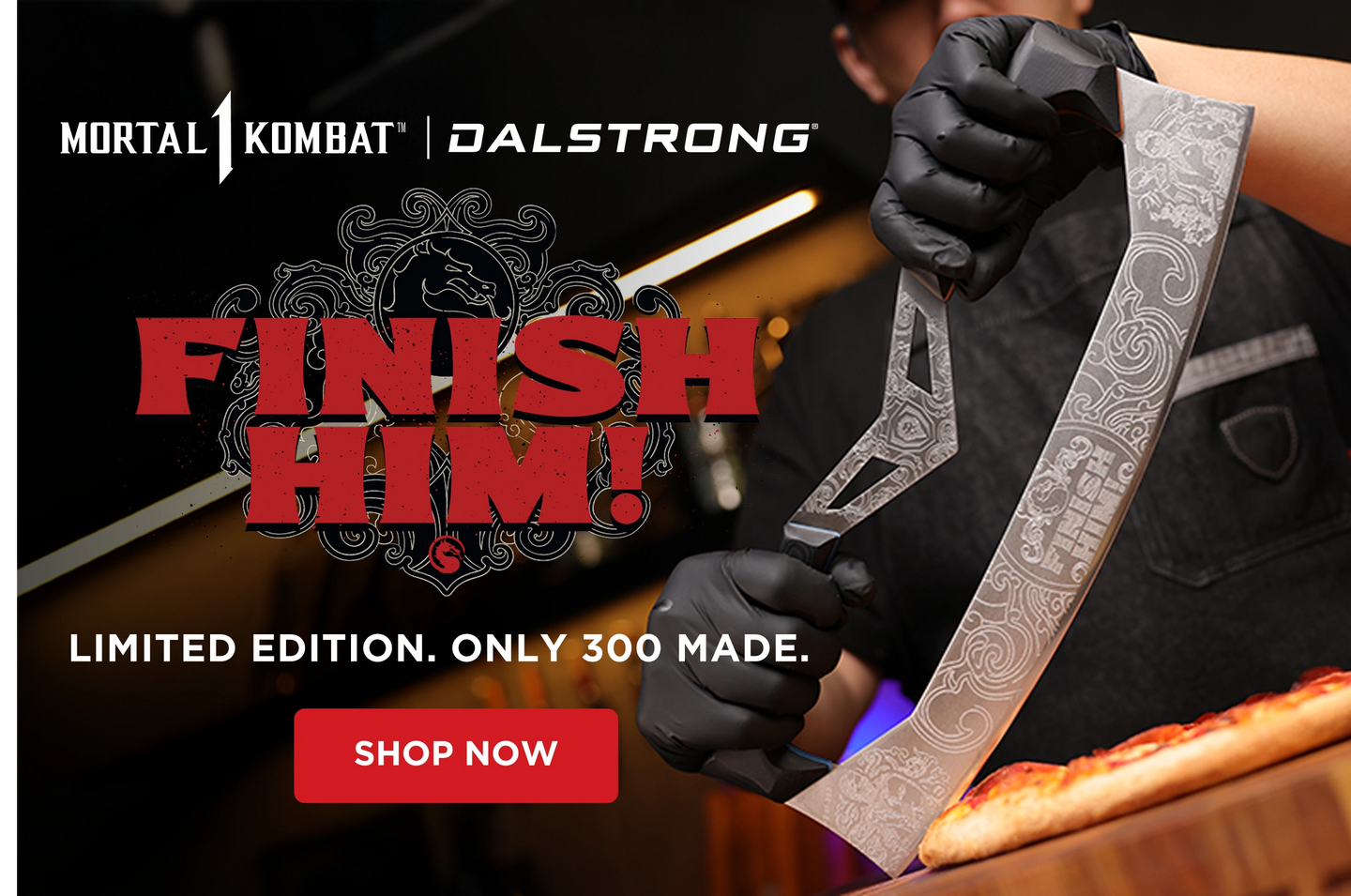4 Piece Steak Knife Set | Shogun Series | Dalstrong ©
Shopping For a Steak Knife? Here's What You Need To Know
- Budget- You pay for what you get, and that’s especially true with knives and knife sets
- Style- Mainly down to preference, but it’s not all about looks
- Function- Lower down the list of considerations due to budget, but ought to be first
- Reviews- When purchasing online, you can’t beat customer feedback
- After-sales- As with reviews, discover how valued you are after making a purchase
- Reliability- Look for customer feedback regarding possible issues and how they are dealt with
- Guarantee- A reputable company will stand by its product after it’s been sold
4-Piece Steak Knife Set | Frost Fire Series | Dalstrong ©
There’s a lot of confusion about whether a steak knife needs to be serrated or if a hollowed or straight edge knife is better. Is it about preference, or is there more to it than that? Hopefully, this blog will help you decide for yourself.
If you’re a meat eater, nothing quite beats a fine steak dinner.
Imagine having to deal with your favorite cut of steak without a steak knife!
Did you know- the most expensive steak in the world comes from Japan? The ‘Wagyu’ steak comes from just four different breeds of cattle. The Wagyu ‘Kobe’ cut can only be called that if it comes from one prefecture in Japan and can reach $110 for a 16oz fillet!
1. What Makes A Good Quality Steak Knife?

4-Piece Steak Knife Set | Shadow Black Series | NSF Certified | Dalstrong ©
Proportion
- The proportions of a steak knife need to balance with its function.
- If the handle appears too large for the blade length, the knife may look cumbersome.
- After all, you wouldn’t expect to see a dainty thin stocked handle on a meat cleaver.
- The balance of the knife needs to look correct for the type of blade.
Feel
- How a steak knife feels in the hand indicates how well it’s made rather than what it’s made from.
- Does a wooden handle score over a composite resin design? In our experience, we’ve found handle style to be purely down to preference.
- Ergonomic handles should count: A comfortable grip- how they ‘feel’ in hand. Too often it’s down to how a knife looks.
- Preference is why we create so many different designs.
Blade length
- Preference is a significant consideration, but a steak knife blade length still needs parameters to function correctly.
- The ideal functional knife blade should be between four and four and a half inches long, with a handle of a similar size.
- This gives both an aesthetic balance but the symmetry that most people look for in a design.
Handle
- There are no hard and fast rules for the design or shape of a handle aside from how it functions.
- A handle is usually tapered from end to end to present a comfortable grip for an average sized hand.
- Most handles incorporate a wider butt to prevent hand slipping off the knife. A bolster or hand guard is utilized for the opposite end near the blade.
- Traditionally, a wooden handle was used as historically, this was the most accessible material to shape.
- However, nowadays, metal, composite resin, or laminate materials are just as expected.
- There are basically two styles of blade construction: The stamped blade and the forged.
- Forged knives are generally stronger than stamped ones and more straightforward to sharpen due to their processing.
- Stamped knives tend to be less expensive as there are less processes in their construction. However, a stamped knife will require sharpening more regularly.
Stamped blades
- Stamped blades are machined from a continuous length of steel.
- A powerful press cutter literally stamps the steel blade's templated shape and a blunted point at the other end. A handle is usually glued or pinned and glued, and the knife is shaped, sharpened, and then polished.
Forged and Tanged Steak Knife
- When steak knife blades are forged (and other kitchen knives such as a chef’s knife, cleaver, paring knife, or carving knife) the blade length forms only part of the material.
- The tang extends into the handle, so the knife is less likely to break where the handle meets the blade's end (or 'return').
- A tanged knife is considered more robust and of superior quality.
Did you know - the word ‘tang’ originated from the term used for a serpent's tongue?
How To Differentiate Between a Stamped and Forged Knife
- Contrary to popular belief, telling a stamped knife from a forged blade is not as simple as it used to be.
- Historically, a stamped knife used to be flat with a sharpened edge and there would be no bolster (a band joining the knife blade to the handle)
- A bolster was a determining factor between forged or stamped knives.
- However, with modern manufacturing, blades can be ground down from thicker stock, and some may even have a bolster.
- A high-quality stamped knife can fool even experienced bladesmiths, so read the descriptions before purchasing or reading the reviews.
2. Different Types Of Steak Knives
Steak Knife Set | Crusader Series | Dalstrong ©
1. The Plain Steak Knife Blade - aka, The Straight Edge Steak Knife
Let’s be clear here; by plain steak knife’, I don’t mean ordinary.
Plain edged knives are also known as a straight edge.
Flat profile, straight edge knives still have a place in the steak knife manufacturing industry. However, traditionalists often prefer the no-fuss, no-frills approach to steak cutting and knife design.
Sharpening a conventionally shaped blade edge is usually straightforward. As long as it’s a quality steak knife, maintaining sharp edge retention is relatively simple. A few strokes every now and then on a quality knife sharpener, and the blade is as good as new.
The plain steak knife can be thought of as a utility knife too.
These blades handle meats just as quickly as vegetables and fruit and can even be used for peeling and dicing.
Any chef worth his salt will have his straight edged chef knife to cut all manner of foods around his kitchen. A plain edged blade is the stalwart kitchen knife.
2. The Serrated Edge Steak Knife
The serrated edge blade is still considered the ‘go-to’ knife choice for steak.
With modern methods of stainless steel blades hardening and edge retention, a serrated blade sharp knife is much easier to maintain.
But the reason for a serrated edge may surprise you.
It’s not because of the greater surface area of sharpness to deal with tougher meat!
Serrated edges were invented to ensure that less of the blade area touches materials likely to dull the blade.
Sure, bread knives and tomato knives are also serrated, but that's due to a straight edge knife's 'crushing' effect.
Ceramic plates, metal countertops, a wooden cutting board, and even a poorly constructed knife block contribute to dulling a blade over time.
As you cut through your favorite fillet steak, eventually, you’ll hit the plate (or the flat slate or wooden block that modern restaurants seem to find fashionable!)
A serrated blade keeps its edge longer with less of the blade making contact with the abrasive material.
Did you know- the valleys of a serrated edge blade are also known as ‘gullets’ ?
Bonus : How To Sharpen a Serrated Edge KnifeThough knife sharpening is not needed nearly as regularly as a straight edge blade, serrated knives do require maintenance from time to time.
A chef sharpening steel is an invaluable tool for any kitchen.
If you study a serrated steak knife, you’ll see that one side has an angled valley or ‘gullet’, and the other isn't angled at all.
Pass the steel downward on the regular angled side three or four times through each serration, pushing the resulting burr to the non-angled side of the blade.
Gently honing the non angled side a couple of times will remove the burr and bring back the sharpness of the blade.
3. Hollow Edge Steak knife
The description ‘hollow edge; can be confused with serrated, but it’s the sides of the blade that are hollowed out and not the blade edge.
These regular small indentations are included to induce tiny air bubbles between the blade and the meat (or whatever food you are attempting to cut).
The science behind this is to reduce the friction between the blade and the food, leading to cleaner cutting.
Hollow edge blades have crept into many styles of a knife over the years. The hollowed feature not only creates a more interesting design but is functional and looks attractive.
3. What To Look For When Purchasing Steak Knives
4 Piece Steak Knife Set | Shogun Series | Dalstrong ©
Budget
- Consider the manufacturing processes that make a quality steak knife: The superior materials used and their uniqueness.
- Look for high carbon stainless steel as they stay sharper for longer than standard stainless steel.
- Remember that a knife with a tang is usually more robust than a stamped knife.
Style
- Unless you’ve fallen in love with the one set of knives a company supplies, look for alternatives.
- Consider the handles, color, blade length and composition, and how impressive they are.
Function
- How well a knife performs in the kitchen is obviously a major consideration.
- Do they cut easily and keep their edge after some heavy use?
- Are they easily cleaned?
- Are there any gaps or ridges that may collect food?
Reviews and After Care
- Ensure that you’re not left with an expensive dud set of knives that you’re not happy with. Read the reviews and examine the company’s reputation.
- Check how you’ve been looked after during, and after your sale.
- Don’t hesitate to raise any concerns you may have.
4. The Dalstrong Collection Of Steak Knives
Below are 5 fantastic options for your next steak knives set purchase.
1. 4 Piece Steak Knife Set | Shogun Series | Dalstrong ©
Why We Think You’ll Love Them
- One of our best sellers, the ‘Shogun’ range, is the ultimate in traditional style and design.
- The super-keen sharp blades ensure perfect steak slicing and present so well on any dinner table.
- Manufacturing processes take 60 days to ensure high quality and craftsmanship.
- The handles are molded from G-10 Garolite, a solid military-grade inert and non-porous fiberglass-like material. As a result, strength is never a problem.
Why You May Prefer Something a Little Different
- The blades are made from the traditional straight edge design.
- Some may prefer a serrated steak knife or a hollow edge, or a more modern look.
2. 4-Piece Steak Knife Set | Shadow Black Series | NSF Certified | Dalstrong ©

Why We Think You’ll Love Them
- The dark, sleek look of mystique and intrigue. The ‘Shadow Black’ series emanates power and strength.
- Almost comic book in design, yet belying their efficiency.
- The knives scream their sharpness, and the grips not only look but feel out of this world.
- Their unique handle geometry (inspired by the F-117 Nighthawk Stealth Fighter) features aerodynamic lines that tuck snugly into your palm.
- Coated with a black titanium finish which adds to their non-stick nature, these knives are sure to turn heads in any kitchen.
- This is one evil-looking knife.
Why You May Prefer Something a Little Different
- This out-of-this-world design isn’t for everyone.
- If your kitchen is cottage style, these are probably not for you!
3. 4-Piece Steak Knife Set | Frost Fire Series | Dalstrong ©
Why We Think You’ll Love Them
- This lightweight, steak knives set oozes performance and style.
- The honeycombed icy handle is ergonomically designed for a comfort grip, and 7 layers of high-carbon steel make for a beautiful, almost Japanese knife in style.
- Every blade is sandblasted to produce a frosted effect and add to its pristine appearance.
- Elegance personified.
Why You May Prefer Something a Little Different
- Beauty is in the eye of the beholder. What we look at as beautiful may not resonate with you.
- Perhaps the color, grip style, or frosting is not what you’re looking for.
4. Steak Knife Set | Crusader Series | NSF Certified | Dalstrong ©
Why We Think You’ll Love Them
- The 'Crusader' series offers aesthetic beauty with functional cleanliness and performance, a new collection of all minimalistic steel designs.
- The Crusader’s neutrality of color and style makes it easy to fit into any kitchen without conflicting with decor.
- The Crusader looks and is a hygienic steak knife and yet still offers efficient razor sharpness.
Why You May Prefer Something a Little Different
- The Crusader may be a little too minimalist for your taste.
- You may be looking for a more substantial grip handle.
5. 4-Piece Straight-Edge Steak Knife Set | Gladiator Series | NSF Certified | Dalstrong ©
Why We Think You’ll Love Them
- The ‘Gladiator’ Series 5” straight-edge steak knives are masters of meat cutting. So sharp as to almost seem cruel.
- Nothing has been left to chance with the hollow edge design and molded handle.
- They’re so beautiful, don’t be surprised if your guests let their meals go cold while staring in admiration!
- From thick cuts of rib-eye steak to tender chicken, the Gladiator Series straight-edge steak knives ensure effortless slicing.
- Lock in the succulence of the meat with the smooth cuts from these knives. Hollow divots minimize friction and reduce the chances of stuck-on food.
- The included sheaths protect blades when not in use, as well as fingers.
- For exceptional performance and impeccable craftsmanship, the Gladiator steak knife belongs in your kitchen.
Why You May Prefer Something a Little Different
- Perhaps the color of the handles don’t float your boat, or you’re looking for a complete knife set?
- Maybe you prefer a narrower blade?
5. How To Set A Formal Table For a Steak Dinner
While we’re here...
We’re often asked how to set up a formal table for a three or more course dinner, so what better an opportunity than to explain when writing about one of the nation’s favorite meals.
You can also check out our comprehensive guide on how to set a table here!

4-Piece Steak Knife Set | Shadow Black Series | NSF Certified | Dalstrong ©
Follow this guide, and any restaurant would be proud of your display.
As a general rule, place utensils from outside to inside according to sequence of use.
Each place setting requires the following;
- A dinner plate placed centrally
- A dinner fork to the left hand of the plate
- A dinner knife to the right hand of the plate- with the blade edge facing the plate
- Unless the meal is definitely steak (in a steakhouse, for example), the dinner knife is swapped before the meal arrives
- Either a place or soup spoon to the right of the knife
- The napkin is either placed to the left of the fork or above the plate
- Some settings allow for the napkin to sit on the plate in a napkin ring, or folded cleverly for presentation
- Often, a dessert spoon and knife are placed above the plate
Did you know- the term ‘flatware’ relating to the word for serving cutlery originated in the 19th century in the USA and didn’t include knives?
6. Frequently Asked Questions About Steak Knives
Gladiator Series 8-Piece Steak Set
What is a steak knife used for?Yes, we know it seems an obvious answer but it’s not that simple. For example a steak knife is designed to cut through tough cooked or tender meat at the dinner table, not just steak.
What is the best steak knife?A knife that’s sharp, comfortable to grip, and hygienically formed: No areas where food may get trapped and therefore bacteria to manifest. The handle should feel like part of the knife and not be loose and the knife’s balance should make cutting safe and straightforward.
How much does a steak knife cost?Just how long is that piece of string? Unfortunately, there is no correct answer as the cheaper end of the market will cost a couple of dollars, whereas a quality steak knife could be a couple of hundred.
Is my steak knife dishwasher safe?No high-quality knives should be placed in a dishwasher. The abrasive detergents tend to dull the edge over time. In addition, as the blades are razor-sharp, placing them in a dishwasher is potentially dangerous and more prone to accidents.
- Instead, use soapy washing up liquid and grab yourself a sponge
- Apply the washing up liquid directly to your wet sponge
- Carefully wipe the sponge across the knife from its spine to the cutting edge to remove any debris or residue
- Rinse and dry with a kitchen towel or cloth.
Dinner knives are the utility knives in cutlery: They do most jobs well. However, a steak knife is specifically designed to cut meat that most dinner knives would struggle with.
When ordering steak in a restaurant, the dinner knife is almost always replaced with a steak knife.
Where does the steak knife go in a place setting?The steak knife replaces the dinner knife in the table setting if the customer has requested steak. The knife sits to the right of the plate, with the dinner fork on the left.
When was the steak knife invented?Though sharp knives have been around for centuries, the steak knife in its recognized form was only introduced around 1890.
An influential French clergyman, Cardinal Armand Jean du Plessis (otherwise known as Cardinal Richelieu) was disgusted by what he considered the revolting table manners of his guests. After a meal, he watched as most used the sharp points of their dinner knives as toothpicks. Because of the Cardinal’s influence, a law was passed to blunt and round the dinner knife to how we know it today.
Do steak knives need to be serrated?Absolutely not. A serrated edge is a personal preference.
Superior manufacturing of quality hardened high carbon stainless steel means that edge retention is longer with a straight edge knife.
SHOP ALL DALSTRONG STEAK KNIVES TODAY

































